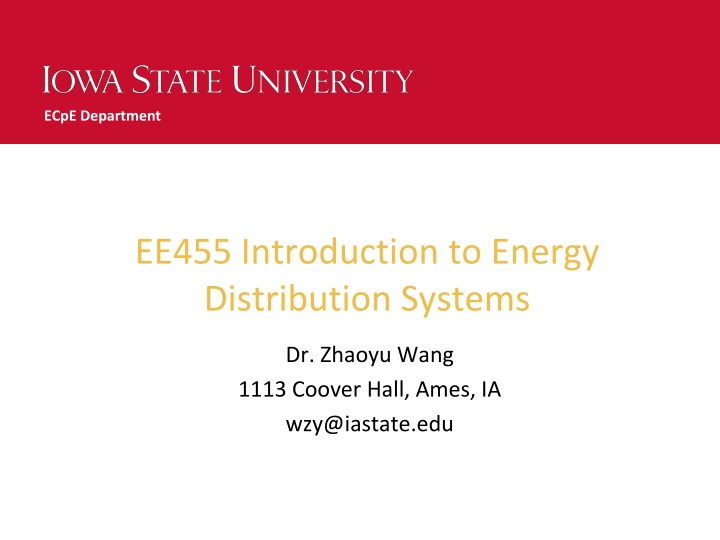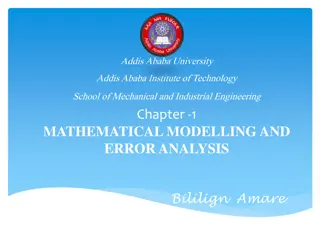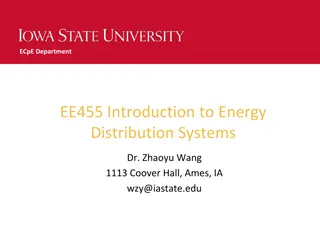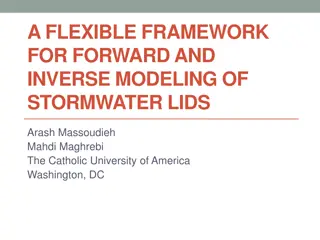
Energy Distribution Systems Overview and Shunt Admittance Modeling
Explore the modeling of shunt admittance in energy distribution systems, covering conductor types, potential coefficients, and capacitance matrices. Understand the principles behind shunt admittance calculations for overhead and underground lines. Learn about the voltage drop equations in distribution networks.
Download Presentation

Please find below an Image/Link to download the presentation.
The content on the website is provided AS IS for your information and personal use only. It may not be sold, licensed, or shared on other websites without obtaining consent from the author. If you encounter any issues during the download, it is possible that the publisher has removed the file from their server.
You are allowed to download the files provided on this website for personal or commercial use, subject to the condition that they are used lawfully. All files are the property of their respective owners.
The content on the website is provided AS IS for your information and personal use only. It may not be sold, licensed, or shared on other websites without obtaining consent from the author.
E N D
Presentation Transcript
ECpE Department EE455 Introduction to Energy Distribution Systems Dr. Zhaoyu Wang 1113 Coover Hall, Ames, IA wzy@iastate.edu
Modeling Shunt Admittance of Overhead and Underground Lines Acknowledgement: The slides are developed based in part on Distribution System Modeling and Analysis, 4th edition, William H. Kersting, CRC Press, 2017 2
Overview Conductor Types (materials) & Construction Info (spacings) Primitive Potential Coefficient Matrix ?????????? Self and Mutual Potential Coefficients Kron reduction Partition Form Phase Potential Coefficient Matrix [Pabc] Capacitance Matrix [Cabc] ??? ??? ??? ??? ?????????? = Phase Shunt Admittance Matrix [yabc] 3 ECpE Department
Shunt Admittance of Overhead and Underground Lines The shunt admittance of a line consists of the conductance and the capacitive susceptance. The conductance is usually ignored because it is very small compared to the capacitive susceptance. The capacitance of a line is the result of the potential difference between conductors. A charged conductor creates an electric field that emanates outward from the center of the conductor. Lines of equipotential are created that are concentric to the charged conductor. This is illustrated in Fig.1. Fig.1 Electric field of a charged round conductor 4 ECpE Department
Shunt Admittance of Overhead and Underground Lines In Fig.1, a difference of potential between two points (P1 and P2) is a result of the electric field of the charged conductor. When the potential difference between the two points is known, then the capacitance between the two points can be computed. If there are other charged conductors nearby, the potential difference between the two points will be a function of the distance to the other conductors and the charge on each conductor. The principle of superposition is used to compute the total voltage drop between two points and then the resulting capacitance between the points. The points can be points in space or the surface of two conductors or the surface of a conductor and ground. 5 ECpE Department
General Voltage Drop Equation Fig.2 shows an array of N positively charged solid round conductors. Each conductor has a unique uniform charge density of q cb/m. The voltage drop between conductor i and conductor j as a result of all of the charged conductors is given by ?1? ?1?+ ?? ln ??? ???+ ?? ln ??? ???+ ?? ln ??? ???) 1 ?ij= 2?? (?1 ln (1) Fig.2 Array of round conductors 6 ECpE Department
General Voltage Drop Equation ?1? ?1?+ ?? ln ??? ???+ ?? ln ??? ???+ ?? ln ??? ???) (1) 1 ?ij= 2?? (?1 ln Equation (1) can be written in a general form as ??? ??? 1 (2) ? ?ij= 2?? ?=1 ?? ln where = 0 ris the permittivity of the medium, 0 is the permittivity of free space = 8.85 10 12 F/m, r is the relative permittivity of the medium qn is the charge density on conductor n cb/m Dni is the distance between conductor n and conductor i (ft) Dnj is the distance between conductor n and conductor j (ft) Dnn is the radius (RDn) of conductor n (ft) 7 ECpE Department
Overhead Lines The method of conductors and their images is employed in the calculation of the shunt capacitance of overhead lines. This is the same concept that was used in the general application of Carson's equations. Figure 3 illustrates the conductors and their images and will be used to develop a general voltage drop equation for overhead lines. Fig.3 Conductors and images 8 ECpE Department
Overhead Lines In Fig.3 it is assumed that = ??, ?? = ?? (3) ?? Appling Equation (2) to Figure 5.3, ??? ???+ ?? ??? ???) 1 ??? ???+ ?? ln??? ln ?ii = 2?? (?? ln ???+ ?? ln (4) Fig.3 Conductors and images 9 ECpE Department
Overhead Lines = ??, ?? = ?? (3) ?? ??? ???+ ?? ??? ???) 1 ??? ???+ ?? ln??? ln ?ii = (4) 2?? (?? ln ???+ ?? ln Because of the assumptions of Equation (3), Equation (4) can be simplified to ??? ??? ?j ln ??? ??? 1 ??? ??? ?? ln??? ??? ???+?? ln ??? ???+ 2?? ln ?ii= ?? ln ???+ ?? ln 2?? ??? ???+?j ln ??? ??? 1 ??? ???+ ?? ln ??? ??? = ?? ln 2?? 1 = (5) 2?? ln 2?? where Sii is the distance from conductor i to its image i (ft) Sij is the distance from conductor i to the image of conductor j (ft) Dij is the distance from conductor i to conductor j (ft) RDi is the radius of conductor i in ft Fig.3 Conductors and images 10 ECpE Department
Overhead Lines ??? ??? 1 ??? ???+ 2?? ln ?ii = (5) 2?? ln 2?? Equation (5) gives the total voltage drop between conductor i and its image. The voltage drop between conductor i and ground will be one-half of that given in Equation (5): ??? ??? 1 ??? ???+ ?? ln (6) ?ig= ?? ln 2?? Equation (6) can be written in general form as ?ig= ??? ??+ ??? ?? (7) where ??? and ??? are the self- and mutual potential coefficients. For overhead lines the relative permittivity of air is assumed to be 1.0 so that ?0=1.0 8.85 10 12 ? ?, ?air=1.4240 10 2 ??/???? Using the value of permittivity in F/mile, the self- and mutual potential coefficients are defined as ???= 11.17689 ln (8) ??? ??? mile/?? ??? ?? mile/?? (9) ???= 11.17689 ln (10) 11 ECpE Department
Overhead Lines ??? ??? mile/?? ??? ?? mile/?? ???= 11.17689 ln (9) (10) ???= 11.17689 ln Note: In applying Equations (9) and (10), the values of RDi, Sii, Sij, and Dij must all be in the same units. For overhead lines the distances between conductors are typically specified in feet while the value of the conductor diameter from a table will typically be in inches. Care must be taken to ensure that the radius in feet is used in applying the two equations. For an overhead line of ncond conductors, the primitive potential coefficient matrix can be constructed. The primitive potential coefficient matrix will be an ncond ncond matrix. For a four-wire grounded wye line the primitive coefficient matrix will be of the form ??? ??? ??? ??? ??? ??? ??? ??? ??? ??? ??? ??? ??? ??? ??? ??? ?????????? = (11) 12 ECpE Department
Overhead Lines ??? ??? ??? ??? ??? ??? ??? ??? ??? ??? ??? ??? ??? ??? ??? ??? (11) ?????????? = The dots ( ) in Equation (11) are partitioning the matrix between the third and fourth rows and columns. In partitioned form Equation (11) becomes ??? ??? ??? ??? (12) ?????????? = Because the neutral conductor is grounded, the matrix can be reduced using the Kron reduction method to an n-phase n-phase phase potential coefficient matrix [Pabc] given by [????]= ???- ??? ??? 1 ??? (13) The inverse of the potential coefficient matrix will give the n-phase n-phase capacitance matrix [Cabc]: [????]= ???? 1 (14) 13 ECpE Department
Overhead Lines 1 [????]= ???? (14) For a two-phase line the capacitance matrix of Equation (14) will be 2 2. A row and a column of zeros must be inserted for the missing phase. For a single-phase line, Equation (14) will result in a single element. Again rows and columns of zero must be inserted for the missing phase. In the case of the single-phase line, the only nonzero term will be that of the phase in use. Neglecting the shunt conductance, the phase shunt admittance matrix is given by [????]= 0 + ? ? [????] ??/???? (15) where ? = 2 ? ? = 376.9911 14 ECpE Department
Example 1 Determine the shunt admittance matrix for the overhead line. Assume that the neutral conductor is 25 ft above ground. The diameters of the phase and neutral conductors from the conductor table (Appendix A) are: Conductor, 336,400 26/7 ACSR, ??= 0.721 ??.,???= 0.03004 ??; 4/0 6/1 ACSR, ??= 0.563 ??.,???= 0.02346 ?? 15 Overhead line of Example 4.1 ECpE Department
Example 1 Using the Cartesian coordinated in Example 4.1, the image distance matrix is given by ???= ?? ?? is the conjugate of ?? Where ?? For the configuration the distances between conductors and images in matrix form are 58 58.0539 58.4209 54.1479 54.0208 The self-primitive potential coefficient for phase a and the mutual primitive potential coefficient between phases a and b are ???= 11.17689 ln 58.0539 58 58.1743 58.4209 58.1743 58 54.0833 54.1479 54.0208 54.0833 50 ?? ? = 58 0.03004= 84.5600 mile/?? ???= 11.17689 ln58.0539 = 35.1522 mile/?? 2.5 16 ECpE Department
Example 1 ??? ??? mile/?? ??? ?? mile/?? (9) (10) ???= 11.17689 ln ???= 11.17689 ln Using Equations (9) and (10), the total primitive potential coefficient matrix is computed to be 84.5600 35.1522 23.7147 25.2469 28.3590 Since the fourth conductor (neutral) is grounded, the Kron reduction method is used to compute the phase potential coefficient matrix. Because only one row and one column need to be eliminated, the [ ???] term is a single element so that the Kron reduction equation for this case can be modified to 23.7147 28.6058 84.5600 26.6131 35.1522 84.5600 28.6058 25.2469 28.3590 26.6131 85.6659 ?????????? = mile/?? ??4 ??4 ?44 ???= ??? where i = 1, 2, 3 and j = 1, 2, 3. 17 ECpE Department
Example 1 For example, the value of Pcb is computed to be ?34 ?24 ?44 = 28.6058 26.6134 28.359 ???= ?32 = 19.7957 85.6659 Following the Kron reduction, the phase potential coefficient matrix is 77.1194 26.7944 15.8714 26.7944 75.1720 19.7957 15.8714 19.7957 76.2923 ????= Invert [Pabc] to determine the shunt capacitance matrix: 0.015 0.0049 0.0019 0.0049 0.0159 0.0031 0.0019 0.0031 0.0143 ????=[?] 1= Multiply [Cabc] by the radian frequency to determine the final three-phase shunt admittance matrix: ?5.6711 ?1.8362 ?0.7033 ?1.8362 ?5.9774 ?1.169 ?0.7033 ?1.1690 ?5.3911 ????=j*376.9911* ????= ??/???? 18 ECpE Department
Concentric Neutral Cable Underground Lines Most underground distribution lines consist of one or more concentric neutral cables. Fig.4 illustrates a basic concentric neutral cable with center conductor being the phase conductor and the concentric neutral strands displaced equally around a circle of radius Rb. Fig.4 Conductors and images 19 ECpE Department
Concentric Neutral Cable Underground Lines Referring to Fig.4 the following definitions apply: Rb represents the radius of a circle passing through the centers of the neutral strands. dc represents the diameter of the phase conductor. ds represents the diameter of a neutral strand. k represents the total number of neutral strands. Fig.4 Conductors and images 20 ECpE Department
Concentric Neutral Cable Underground Lines ??? ??? 1 (2) ? ?ij= 2?? ?=1 ?? ln The concentric neutral strands are grounded so that they are all at the same potential. Because of the stranding, it is assumed that the electric field created by the charge on the phase conductor will be confined to the boundary of the concentric neutral strands. In order to compute the capacitance between the phase conductor and ground, the general voltage drop of Equation (2) will be applied. Since all of the neutral strands are at the same potential, it is necessary to determine only the potential difference between the phase conductor p and strand 1. ??1= 1 ?? ???+ ?1 ln??? ??+ ?2 ln?12 ??+ ?? ln?1? ??+ ?? ln??1 2?? (?? ln ??) (16) where ???=?? 2,???=?? 2 It is assumed that each of the neutral strands carries the same charge such that ?1= ?2= ??= ??= ?? (17) ? 21 ECpE Department
Concentric Neutral Cable Underground Lines 1 ?? ???+ ?1 ln??? ??) ??+ ?2 ln?12 ??1= ln?1? 2?? (?? ln ??+ ?? ln??1 ??+ ?? (16) Equation (16) can be simplified to ?? ? 1 ?? ??? ?ln??? ?12 ?1? ?1? ln??? ??+ ln?12 ??+ + ln?1? ??+ + ln??1 ??1= ?? ln 2?? ?? 2?? ?? ?? ??? 1 = ln (18) ? ?? 22 ECpE Department
Concentric Neutral Cable Underground Lines The numerator of the second ln term in Equation (18) needs to be expanded. The numerator represents the product of the radius and the distances between strand i and all of the other strands. Referring to Fig.4, the following relations apply: ?12=2? ? ?13= 2?12=4? ? In general, the angle between strand #1 and any other strand #i is given by ? 1 2? ? ?1?= (? 1)?12= Fig.4 Conductors and images 23 ECpE Department
Concentric Neutral Cable Underground Lines The distances between the various strands are given by ?12= 2 ?? sin(?12 2) = 2 ?? sin(? 2) = 2 ?? sin(2? ?) (20) ?13= 2 ?? sin(?13 ?) The distance between strand 1 and any other strand i is given by ?1?= 2 ?? sin(?1? 2) = 2 ?? sin(? 1 ? (21) ) ? Equation (21) can be used to expand the numerator of the second log term of Equation (18): ??? ?12 ?1? ?1? ? ? ? 2? 2sin((? 1)? ) 2sin((? 1) ? 1[2sin = ??? ?? 2sin )] ? ? (22) 24 ECpE Department
Concentric Neutral Cable Underground Lines ??? ?12 ?1? ?1? ? ? ? 2? 2sin((? 1)? ) 2sin((? 1) (22) ? 1[2sin = ??? ?? 2sin )] ? ? (23) ??? = ? [?] The distance between strand 1 and any other strand i is given by ?1?= 2 ?? sin(?1? 2) = 2 ?? sin(? 1 ? (21) ) ? Equation (21) can be used to expand the numerator of the second log term of Equation (18): ??? ?12 ?1? ?1? ? ? ? 2? 2sin((? 1)? ) 2sin((? 1) (22) ? 1[2sin = ??? ?? 2sin )] ? ? 25 ECpE Department
Concentric Neutral Cable Underground Lines ? 1 ?? 2?? ?? 2?? ?lnk ??? ?? ?? ??? 1 ?? ??? 1 ?lnk ??? ??1= = (24) ln ln ? ?? ?? Since the neutral strands are all grounded, Equation (24) gives the voltage drop between the phase conductor and ground. Therefore, the capacitance from phase to ground for a concentric neutral cable is given by ?? ??1= 2?? 1 ?) ln(? ???= (25) ????? ( ln ?????) where = 0 r is the permittivity of the medium 0 is the permittivity of free space = 0.01420 F/mile r is the relative permittivity of the medium 26 ECpE Department
Concentric Neutral Cable Underground Lines The electric field of a cable is confined to the insulation material. Various types of insulation material are used, and each will have a range of values for the relative permittivity. Table.1 gives the range of values of relative permittivity for four common insulation materials. Table.1 Typical Values of Relative Permittivity (??) Material Range of Value of Relative Permittivity Polyvinyl chloride (PVC) 3.4-8.0 Ethylene-propylene rubber (EPR) 2.5-3.5 Polyethylene (PE) 2.5-2.6 Cross-linked polyethylene (XLPE) 2.3-6.0 27 ECpE Department
Concentric Neutral Cable Underground Lines Cross-linked polyethylene is a very popular insulation material. If the minimum value of relative permittivity is assumed as 2.3, the equation for the shunt admittance of the concentric neutral cable is given by 77.3619 1 ?)ln(? ???= 0 + ? ?????) ??/???? ????? ( ln (26) 28 ECpE Department
Example 3 Determine the three-phase shunt admittance matrix for the concentric neutral line. ??= ? = 0.0511 ?? = 0.631 ?? Diameter of the 250,000 AA phase conductor = 0.567 in. Therefore, ???=0.567 = 0.2835 ?? 2 Diameter of the #14 CU concentric neutral strand = 0.0641 in. Therefore, ???=0.0641 = 0.03205 ?? 2 29 ECpE Department
Example 3 Substitute into (26) 77.3619 1 ?)ln(? (26) ???= ? ????? ( ln ?????) 77.3619 1 13)ln(13 ???= ? 0.6132 0.2835 ( = ?96.6098 ??/???? ln 0.03205 0.6132) The phase admittance for this three-phase underground line is ?96.6098 0 0 0 0 0 ????= ??/???? ?96.6098 0 ?96.6098 30 ECpE Department
Tape-Shielded Cable Underground Lines A tape-shielded cable is shown in Figure 5. Referring to Figure 5 Rb is the radius of a circle passing through the center of the tape shield. As with the concentric neutral cable, the electric field is confined to the insulation so that the relative permittivity of Table 1 will apply. Table 1 Typical Values of Relative Permittivity (??) Material Range of Value of Relative Permittivity Polyvinyl chloride (PVC) 3.4-8.0 Ethylene-propylene rubber (EPR) 2.5-3.5 Polyethylene (PE) 2.5-2.6 Cross-linked polyethylene (XLPE) 2.3-6.0 Fig.5 Tape-shielded conductor 31 ECpE Department
Tape-Shielded Cable Underground Lines ?? ? 1 ?? ??? ?ln??? ?12 ?1? ?1? ln??? ??+ ln?12 ??+ + ln?1? ??+ + ln??1 ??1= ?? ln 2?? ?? 2?? ?? (18) ?? ??? 1 = ln ? ?? The tape-shielded conductor can be visualized as a concentric neutral cable where the number of strands k has become infinite. When k in Equation (18) approaches infinity, the second term in the denominator approaches zero. Therefore, the equation for the shunt admittance of a tape-shielded conductor becomes 77.3619 ln ????? (27) ???= 0 + ? ??/???? 32 ECpE Department
Example 4 Determine the shunt admittance of the single-phase tape-shielded cable. Outside diameter of the tape shield is 0.88 in. The thickness of the tape shield (T) is 5 mil. The radius of a circle passing through the center of the tape shield is given by ? = 1000= 0.005 5 ??=?? ? =0.88 0.005 = 0.4375 in 2 2 The diameter of the 1/0 AA phase conductor is 0.368 in. Therefore, ?? 2=0.368 = 0.1840 in ???= 2 Substitute into Equation (27): 77.3619 ln ????? 77.3619 0.4375 0.184 ???= ? = ? = ?89.3179 ??/???? ln 33 ECpE Department
Example 5.4 The phase admittance for this three-phase underground line is 0 0 0 0 0 0 0 ????= ??/???? ?89.3179 0 34 ECpE Department
Sequence Admittance The sequence admittances of a three-phase line can be determined in much the same manner as the sequence impedances were determined. Assume that the 3 3 admittance matrix is given in S/mile. Then the three-phase capacitance currents as a function of the line-to-ground voltages are given by ??? ??? ??? ??? ??? ??? ??? ??? ??? ??? ??? ??? ?ca?? ?ca?? ?ca?? (28) = (29) ?ca????= ???? ?????? Applying the symmetrical component transformations (30) ?ca?012=[??] 1?ca????=[??] 1???? ?? ???012 35 ECpE Department
Sequence Admittance ?ca?012=[??] 1?ca????=[??] 1???? ?? ???012 (30) From Equation (30), the sequence admittance matrix is given by ?00 ?10 ?20 ?01 ?11 ?21 ?02 ?12 ?22 (31) y012 = [??] 1???? ??= For a three-phase overhead line with unsymmetrical spacing, the sequence admittance matrix will be full. That is, the off-diagonal terms will be nonzero. However, a three-phase underground line with three identical cables will only have the diagonal terms since there is no mutualcapacitance between phases. In fact, the sequence admittances will be exactly the same as the phase admittances. 36 ECpE Department
Thank You! 37 ECpE Department






















